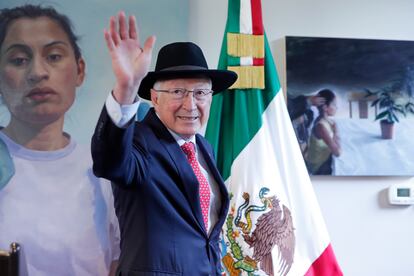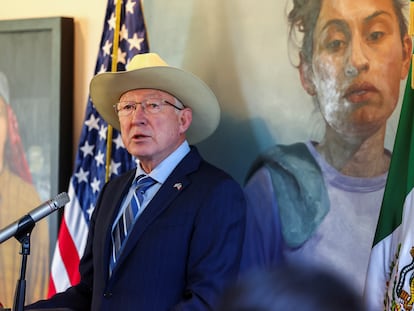The last ride of Ken Salazar, the ambassador in the cowboy hat
The diplomat’s departure marks the end of a cycle in the relationship between Mexico and the United States, and the beginning of an era of complete uncertainty with the return of Donald Trump

After almost three years in office, the time has come to embark on the return trip. Ken Salazar is scheduled to give his last press conference this Monday as the United States representative in Mexico, following Donald Trump’s victory at the November elections and a torrent of tension between both countries in recent months. The farewell of the ambassador in the cowboy hat marks the beginning of a new political cycle in the bilateral relationship, and anticipates a drastic shift in Washington’s policy towards its neighbor: from strategic tolerance to permanent pressure; from talk of cooperation and shared responsibilities to threats and transactional agreements; from Salazar to Ronald Johnson, Trump’s new soldier on Mexican soil.
“We are ready for a new era in the bilateral relationship,” Salazar said in his first speech as ambassador in September 2021. “I come to Mexico proud of my Mexican and American roots, of our shared history, and of the prosperous future that we will build together,” he added at the time. Since then, he has always been seen wearing his famous sombrero, a tribute to his ranching roots and an essential piece of armor in his meetings with governors, entrepreneurs and the then-President Andrés Manuel López Obrador. With Salazar’s appointment, Joe Biden was opting for an eminently political profile – Salazar is also a former senator and former Secretary of the Interior – and for an ally of his absolute trust to oversee first-hand the relationship with the Mexican executive.
Salazar immediately understood that the success of his mission depended on reaching an understanding with López Obrador, who was barely two years older than him. He understood that the president was a man of symbols, a veteran politician with a humble past, like himself. He identified the needs and red lines of his interlocutor, after the traumatic legacy of Trump’s first presidency. And he understood that he could manage within a range of ambivalences to be the transmission belt between both presidents: to represent the interests of the White House, which is the main task of any ambassador, while at the same time acting as the friendly face of American diplomacy.
The ambassador, always more of a politician than a diplomat, came and went frequently from the National Palace in Mexico City. He valued his Mexican allies as equals. He offered to build bridges and not walls. He did not attach special importance to criticism or outbursts against the DEA or the State Department in the president’s morning press conferences, Las Mañaneras. In exchange, the Mexican president granted him the right of access, and reciprocated with declarations of goodwill. “He is my friend and he is a good, sensible man,” López Obrador said about Salazar in July 2022.
During Salazar’s term, Mexico became the United States’ main trading partner. Washington was receptive to Mexico’s request to stop arms trafficking. The Bicentennial Agreement was signed, a new framework for security cooperation. The extraditions that had dropped to a minimum during Enrique Peña Nieto’s presidency were restored. And López Obrador held back the flow of migration, the Achilles heel of the Biden Administration. Both governments constantly insisted that the relationship was “extraordinary.”
But at the same time, and beyond the grandiose statements, many analysts regretted a lack of ambition by both countries to take the relationship to the next level. The desire for an immigration reform that might benefit millions of Mexicans in the United States never took shape. The divergences in the fight against organized crime became evident, to the tune of López Obrador’s claims that “fentanyl is not produced here.” Millions of dollars in funds to strengthen security cooperation remained on hold. The intention to address the social causes of the migration phenomenon in Central America remained just that. Salazar was quite public in his doubts about the energy reform, to cite an example, while the Mexican authorities viewed with suspicion any hint of intervention or criticism about Mexico’s domestic politics.
Outwardly, optimism was still present, but the wear and tear also became more evident. And then, the controversy surrounding the capture of Ismael El Mayo Zambada in the United States and the controversial judicial reform in the Mexican Congress got in the way. Salazar expressed his discomfort from the beginning with the president’s legislative project, first in a subtle way and in the end, without any reservations. “Popular direct election of judges is a major risk to the functioning of Mexico’s democracy,” he said in August.
López Obrador described the statements as “arrogant” and “interventionist” and in September he imposed a confusing “diplomatic pause” on the U.S. embassy, a figure with no basis in international law, but which underscored the break with Salazar. Towards the end of López Obrador’s government, the relationship with the ambassador had reached a standstill. In the eyes of the ruling party, Salazar went from partner to uncomfortable character, a role in which he remained pigeonholed after Claudia Sheinbaum came to power in October.
A week after Trump’s victory at the polls, everything went up in smoke. “Mexico is not safe,” Salazar said in mid-November. “The strategy of ‘hugs, not bullets’ does not work,” he added. Aware that the Republicans’ victory put an expiration date on his own stay in Mexico, the ambassador criticized the strategy of the Mexican authorities and accused López Obrador of cutting off ties with Washington. He also said that the stagnation had been going on for more than a year and, although he did not point to a specific trigger, he noted that the capture of El Mayo in July and the subsequent reproaches were a decisive factor. “The doors were closed then by the Government of Mexico, never by the United States,” he said.
Despite his criticism of López Obrador and the unanswered questions surrounding the arrest of El Mayo, Salazar continued courting Sheinbaum, with whom he had already had contact before. But the new president did not see the point in reestablishing the relationship with the outgoing ambassador or sending a signal that could distance her from her predecessor and mentor, López Obrador. For the Mexican government, Trump’s return to the White House became the new priority.
With two weeks to go before Trump takes office, all the critical areas of the bilateral relationship are compromised: migration, trade and the fight against organized crime. The incoming ambassador, Ron Johnson, is a former Green Beret with two decades of experience in the CIA. With a completely different resume to Salazar’s, one would need to go back more than 30 years to find a profile with similar characteristics in the American embassy.
In mid-December, Salazar held his last major public event: the unveiling of the new U.S. embassy in Mexico City, still under construction. The diplomat wanted to use the embassy as a symbol to illustrate that, despite the uncertainty over Trump, the ties between the two countries are permanent and will continue to grow. He also made the ceremony a testament to his own legacy, despite all the recent misunderstandings and conflicts. “We are more united than ever,” he said in nostalgic tones.
His tenure will go down as a reflection of the promise of a shared future, but also of the suspicions and tensions that continue to exist between two countries condemned to understand one another. It is a promise that at this political moment seems likely to take a backseat, at least for the next four years. The 69-year-old cowboy announced that he will take the road back to Colorado on January 7, one day after his last message in Mexico.
Sign up for our weekly newsletter to get more English-language news coverage from EL PAÍS USA Edition
Tu suscripción se está usando en otro dispositivo
¿Quieres añadir otro usuario a tu suscripción?
Si continúas leyendo en este dispositivo, no se podrá leer en el otro.
FlechaTu suscripción se está usando en otro dispositivo y solo puedes acceder a EL PAÍS desde un dispositivo a la vez.
Si quieres compartir tu cuenta, cambia tu suscripción a la modalidad Premium, así podrás añadir otro usuario. Cada uno accederá con su propia cuenta de email, lo que os permitirá personalizar vuestra experiencia en EL PAÍS.
¿Tienes una suscripción de empresa? Accede aquí para contratar más cuentas.
En el caso de no saber quién está usando tu cuenta, te recomendamos cambiar tu contraseña aquí.
Si decides continuar compartiendo tu cuenta, este mensaje se mostrará en tu dispositivo y en el de la otra persona que está usando tu cuenta de forma indefinida, afectando a tu experiencia de lectura. Puedes consultar aquí los términos y condiciones de la suscripción digital.
More information
Archived In
Últimas noticias
The relentless struggle between factions deepens the Sinaloa war: bodies in coolers and a surge in homicides
‘Doctor Death’, the journalist who has witnessed 105 executions in Florida
Being trans or gay in a migrant detention center: ‘They call me faggot, queer, bitch’
The metaverse, four years later: Is it finished or just at a standstill?
Most viewed
- The low-cost creative revolution: How technology is making art accessible to everyone
- Christian Louboutin: ‘Young people don’t want to be like their parents. And if their parents wear sneakers, they’re going to look for something else’
- All the effects of gentrification in one corner of Mexico’s Colonia Roma
- Liset Menéndez de la Prida, neuroscientist: ‘It’s not normal to constantly seek pleasure; it’s important to be bored, to be calm’
- Christmas loses its festive spirit: ICE fears cast shadow over religious celebrations











































